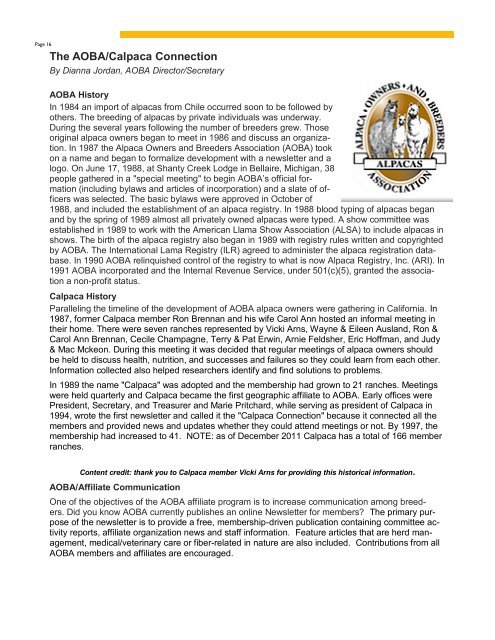You also want an ePaper? Increase the reach of your titles
YUMPU automatically turns print PDFs into web optimized ePapers that Google loves.
Page 16<br />
The AOBA/<strong>Calpaca</strong> Connection<br />
By Dianna Jordan, AOBA Director/Secretary<br />
AOBA History<br />
In 1984 an import of alpacas from Chile occurred soon to be followed by<br />
others. The breeding of alpacas by private individuals was underway.<br />
During the several years following the number of breeders grew. Those<br />
original alpaca owners began to meet in 1986 and discuss an organization.<br />
In 1987 the Alpaca Owners and Breeders Association (AOBA) took<br />
on a name and began to formalize development with a newsletter and a<br />
logo. On June 17, 1988, at Shanty Creek Lodge in Bellaire, Michigan, 38<br />
people gathered in a "special meeting" to begin AOBA’s official formation<br />
(including bylaws and articles of incorporation) and a slate of officers<br />
was selected. The basic bylaws were approved in October of<br />
1988, and included the establishment of an alpaca registry. In 1988 blood typing of alpacas began<br />
and by the spring of 1989 almost all privately owned alpacas were typed. A show committee was<br />
established in 1989 to work with the American Llama Show Association (ALSA) to include alpacas in<br />
shows. The birth of the alpaca registry also began in 1989 with registry rules written and copyrighted<br />
by AOBA. The International Lama Registry (ILR) agreed to administer the alpaca registration database.<br />
In 1990 AOBA relinquished control of the registry to what is now Alpaca Registry, Inc. (ARI). In<br />
1991 AOBA incorporated and the Internal Revenue Service, under 501(c)(5), granted the association<br />
a non-profit status.<br />
<strong>Calpaca</strong> History<br />
Paralleling the timeline of the development of AOBA alpaca owners were gathering in California. In<br />
1987, former <strong>Calpaca</strong> member Ron Brennan and his wife Carol Ann hosted an informal meeting in<br />
their home. There were seven ranches represented by Vicki Arns, Wayne & Eileen Ausland, Ron &<br />
Carol Ann Brennan, Cecile Champagne, Terry & Pat Erwin, Arnie Feldsher, Eric Hoffman, and Judy<br />
& Mac Mckeon. During this meeting it was decided that regular meetings of alpaca owners should<br />
be held to discuss health, nutrition, and successes and failures so they could learn from each other.<br />
Information collected also helped researchers identify and find solutions to problems.<br />
In 1989 the name "<strong>Calpaca</strong>" was adopted and the membership had grown to 21 ranches. Meetings<br />
were held quarterly and <strong>Calpaca</strong> became the first geographic affiliate to AOBA. Early offices were<br />
President, Secretary, and Treasurer and Marie Pritchard, while serving as president of <strong>Calpaca</strong> in<br />
1994, wrote the first newsletter and called it the "<strong>Calpaca</strong> Connection" because it connected all the<br />
members and provided news and updates whether they could attend meetings or not. By 1997, the<br />
membership had increased to 41. NOTE: as of December 2011 <strong>Calpaca</strong> has a total of 166 member<br />
ranches.<br />
Content credit: thank you to <strong>Calpaca</strong> member Vicki Arns for providing this historical information.<br />
AOBA/Affiliate Communication<br />
One of the objectives of the AOBA affiliate program is to increase communication among breeders.<br />
Did you know AOBA currently publishes an online Newsletter for members? The primary purpose<br />
of the newsletter is to provide a free, membership-driven publication containing committee activity<br />
reports, affiliate organization news and staff information. Feature articles that are herd management,<br />
medical/veterinary care or fiber-related in nature are also included. Contributions from all<br />
AOBA members and affiliates are encouraged.


